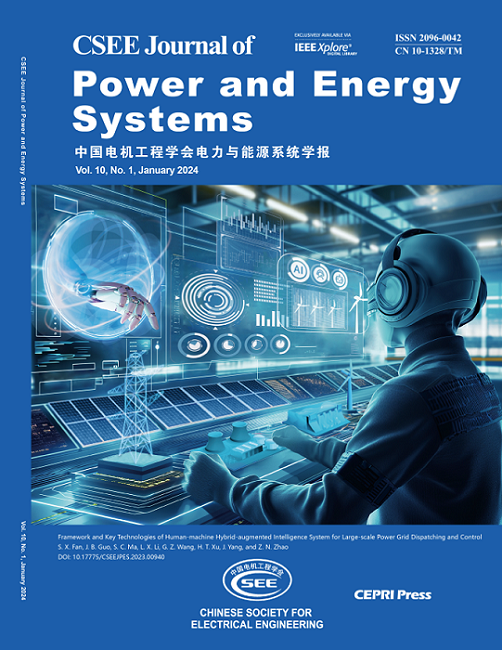水力发电厂电池混合使用的一次频率调节机制
IF 5.9
2区 工程技术
Q2 ENERGY & FUELS
引用次数: 0
摘要
水电站电池混合发电是一项提高水电灵活性的技术创新,有可能扩大水电对电网的贡献,但其基本特征和影响机制尚不清楚。本文研究了这种新技术的一次频率调节(PFR)性能和机理。在基于现场测量数据的水电站(HPP)模型和经过验证的电池简化模型的基础上,建立了电池混合水电站(BH-HPP)模型。通过根定位法和参与因子法对三种不同的电池控制策略进行了系统稳定性和动态分析。与传统水电站相比,分析结果从理论上揭示了 BH-HPP 不仅能加快系统调节速度,还能在 PFR 过程中有效扩大水电站的稳定区域。时域仿真验证了这一结果,并进一步表明合成控制在引入的各种策略中具有更好的性能。此外,还讨论了考虑电池容量和可再生能源情况下控制参数的初始设计范围。这项工作可为水电系统灵活性增强解决方案提供理论支持。本文章由计算机程序翻译,如有差异,请以英文原文为准。
Mechanism of Primary Frequency Regulation for Battery Hybridization in Hydropower Plant
Battery hybridization in hydropower plants is a hydropower flexibility enhancement technology innovation that can potentially expand hydropower's contributions to the grid, but its fundamental characteristics and influencing mechanisms are still unclear. In this paper, primary frequency regulation (PFR) performance and the mechanism of this new technology are studied. A battery hybridized hydropower plant (BH-HPP) model, based on a field-measured-data-based hydropower plant (HPP) model and a verified battery simplified model, is established. Analysis of system stability and dynamics is undertaken for three different battery control strategies by root locus and participation factor methods. Compared to conventional HPPs, analysis results theoretically reveal BH-HPP can not only accelerate system regulation rapidity but also effectively enlarge HPP stability region during PFR process. Time domain simulation verifies the results and further shows synthetic control has better performance among introduced strategies. Besides, initial design ranges of control parameters considering battery capacity and a renewable energy source scenario case are also discussed. This work could provide theoretical support for flexibility enhancement solutions for hydropower systems.
求助全文
通过发布文献求助,成功后即可免费获取论文全文。
去求助
来源期刊

CSEE Journal of Power and Energy Systems
Energy-Energy (all)
CiteScore
11.80
自引率
12.70%
发文量
389
审稿时长
26 weeks
期刊介绍:
The CSEE Journal of Power and Energy Systems (JPES) is an international bimonthly journal published by the Chinese Society for Electrical Engineering (CSEE) in collaboration with CEPRI (China Electric Power Research Institute) and IEEE (The Institute of Electrical and Electronics Engineers) Inc. Indexed by SCI, Scopus, INSPEC, CSAD (Chinese Science Abstracts Database), DOAJ, and ProQuest, it serves as a platform for reporting cutting-edge theories, methods, technologies, and applications shaping the development of power systems in energy transition. The journal offers authors an international platform to enhance the reach and impact of their contributions.
 求助内容:
求助内容: 应助结果提醒方式:
应助结果提醒方式:


